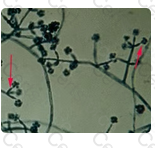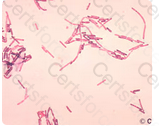The Bethesda assay is used to measure the titer and activity of the antibody present in a patient's sample. Prothrombin time is an initial screening procedure for bleeding disorders and a test used for monitoring anticoagulant therapy. A thrombin time is used to detect heparin interference in an aPTT mixing study. A mixing study is performed to detect the presence of a factor deficiency or coagulation inhibitor, but does not quantify the result.
Hematology
Which of the following tests is used to quantify a coagulation inhibitor?
Rule-out is a process by which antibodies are identified as being unlikely in a given sample because of the absence of an expected antigen-antibody reaction. In other words, the absence of a reaction is noted with a cell that is positive for the corresponding antigen.
Although rule-out procedures may vary somewhat from institution to institution, the following general principles apply:
Non-reactive cells are selected for rule-out. To be classified as non-reactive, a cell must NOT have reacted at any phase of testing in a given panel or screen.
Using the logic that if the rule-out cell is positive for a given antigen, it should have reacted with the corresponding antibody, you can rule-out antibodies that correspond to antigen positive cells.
To increase the probability that rule-out will not mistakenly eliminate a weakly-reacting antibody that exhibits dosage*, use only cells that are homozygous for the corresponding antigen for those systems that generally show dosage. Generally these include: C, c, E, e, Fya, Fyb, Jka, Jkb, M, N, S, and s.
In this case, it is only possible to rule out on screening cell 2 since it demonstrates a negative reaction with the patient serum. Anti-C cannot be ruled out since the C antigen is heterozygous on screening cell 2 with c. Anti-Fya cannot be ruled out since this antigen is not present on screening cell 2. Anti-M and anti-Jka can be ruled out since the antigens are homozyous while demonstrating a negative reaction on screening cell 2.
Rule-out, while very useful, can lead to error. Ruling out an antibody should be combined with other supporting data to increase confidence in the solution; the more data collected, the higher the probability that the final solution is correct.
*Dosage means that there are two "doses" of the same antigen present on the red cells . Antibodies that exhibit dosage react more strongly with homozygous cells (e.g., Jka Jka) than with heterozygous cells (e.g., Jka Jkb) .
Based on the phenotype of the RBC screening cells, and patient results shown on the right, which of the following antibodies CANNOT be ruled out?
If your reactions are strong at immediate spin (3+) and then get weaker at AHG (w+), it could mean the presence of a strong cold antibody.
Cold antibodies tend to be IgM and their optimum phase for reactivity is immediate spin. Incubation and washing of the sample may cause the agglutination that occurred at room temperature to break down. This would appear as a weaker reaction at AHG.
If the reaction strengths varied in each panel cell then that could be an indication that there are multiple antibodies present.
Your screen cells are 3+ at immediate spin and weak (W)+ at AHG. Your auto control is negative for both phases. Some of your antibody panel cells are 3+ at immediate spin and negative at AHG. What should you suspect?
Blood bank
Which of the following is the most common subgroup of A?
A laboratory scientist is preparing a chemical reagent for testing and accidentally spills the chemical on the counter. How is this contamination taken care of?
The production of long, tapered phialides is one of the key identifying features of Trichoderma species. In contrast, Penicillium species, produce phialides with blunt ends.

The phialides of Beauveria species are geniculate, forming a zig-zag pattern.
The arrows in the image on the right point to single, long, tapered phialides that extend laterally from either side of the hyphae. This is an identifying feature of which of the fungi listed below?
Synovial fluid is actually quite viscous and does not have the same consistency as plasma. The reason for its thicker consistency is to provide cushion and reduce friction between the articular cartilage of synovial joints during movement.
Urinalysis & Other Body Fluids
All of the statements below about synovial fluid are true EXCEPT:
All of the following tubes contain separation gel except:
Question options:
Isotonic or normal saline is a 0.85 % solution of sodium chloride in water.
The concentration of sodium chloride in an isotonic solution is :
Failure to tightly seal specimens for sweat electrolytes during collection and transport will cause:
High-sensitivity C-reactive protein (hs-CRP) is used as an aid in the diagnosis and treatment of cardiovascular disease (CVD). At low levels, it can detect those at risk for cardiac heart disease. At high levels in those with no history of heart disease, it indicates a high risk for acute myocardial infarction (AMI), stroke, or peripheral vascular disease. For patients with acute coronary syndrome (ACS) or stable coronary disease, hs-CRP is used to predict future coronary events.
Ranges of hs-CRP in prediction of risk for CVD are:
<1.0 mg/L Low CVD risk
1.0-3.0 mg/L Average risk for CVD
>3.0 mg/L High risk for future CVD
If results are >10.0 mg/L, the patient should be evaluated for an acute inflammatory condition.
Chemistry
A high-sensitivity C-reactive protein (hs-CRP) test result of 5 mg/L (normal = < 1 mg/L) may indicate which of the following?
What is the CORRECT blood-to-anticoagulant ratio for coagulations tests?
Glucagon and epinephrine promote glycogenolysis, conversion of glycogen to glucose, which increases plasma glucose.
Cortisol along with glucagon increases gluconeogenesis, formation of glucose from noncarbohydrates which also raises plasma glucose concentration.
Chem
Which of the following hormones increases plasma glucose concentration by converting glycogen to glucose? Please select all correct answers
The organisms in this image are demonstrating a gram-variable phenomenon. For the most part, the organisms are staining primarily gram-negative, however, on the tips of some of the rods, there is a gram-positive staining morphology. This can be defined as gram-variable.
Which of the following best describes the organisms seen in this illustration:

An employer who fails to provide sufficient personal protective equipment (PPE) for employees may be fined by the: